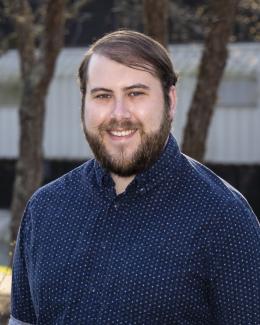Julie Smith: Analyzing scientific problems at the nanoscale
April 9, 2018 – It may take a village to raise a child, according to the old proverb, but it takes an entire team of highly trained scientists and engineers to install and operate a state-of-the-art, exceptionally complex ion microprobe. Just ask Julie Smith, a nuclear security scientist at the Department of Energy’s Oak Ridge National Laboratory.
Smith is a member of the Nuclear Security Advanced Technologies group in the Ultra-Trace Forensic Science Center, where she works with ORNL’s new nanoscale secondary ion mass spectrometer, or NanoSIMS, a powerful imaging instrument that will be used to analyze nuclear fuel cycle materials for DOE and the National Nuclear Security Administration.
NanoSIMS are distinguished from other secondary ion mass spectrometers by their sub-micron resolution, which allows researchers to examine the spatial relationships of different elements and isotopes down to 50 nanometers, less than one one-thousandth the width of an average human hair. This tremendous power enables researchers to perform ultrafine analyses in areas like biochemistry, geosciences and advanced materials and gain a greater understanding of nanoscale chemical interactions.
“It is pretty cool when you’re looking at different ions distributed through a material, whether it be some solid, biological or geological sample,” Smith said. “The scale you can look at it with is just fantastic.”
Smith and her colleagues are currently in the commissioning and validation phase for the instrument, which has been at the lab for less than a year. There are roughly a dozen NanoSIMS instruments in the United States and just three in the national laboratory system. ORNL’s NanoSIMS will be the only one primarily dedicated to studying the nuclear fuel cycle.
“I think the NanoSIMS will dovetail into other techniques that are already available here at ORNL,” Smith said. “We will be able to use the NanoSIMS to answer very specific scientific questions that require nanoscale resolution.”
Smith was originally trained as a geologist and worked in geochronology, determining the age of rock formations, and cosmochemistry, studying meteorites and other samples from outer space to understand the history of the solar system and the galaxy.
She first used a SIMS instrument during her doctoral work, when she used the technology to date rocks more than three billion years old. After completing her degree, she worked for a number of private companies and continued to use the SIMS technique on a variety of materials, from geological and biological matter to semiconductors and nuclear forensics samples.
Smith encountered the NanoSIMS more than a decade ago while working at Lawrence Livermore National Laboratory and was hooked by the instrument’s ability to breach the micron resolution barrier. When she discovered ORNL was getting a NanoSIMS, she jumped at the chance to get in on the ground floor with an updated model that she had never used before.
“NanoSIMS has always been my favorite type of SIMS instrument,” she said. “I was really excited about the opportunity to come and work with this group, use the NanoSIMS and stand up a new laboratory.”
ORNL is a good fit for the NanoSIMS, Smith said, as it has both the facilities and people necessary to set up and maintain the unique, sensitive instrument. It normally takes more than two years from when an order is placed to deliver and install a NanoSIMS, but thanks to ORNL’s extensive support network, the schedule was greatly accelerated and cut that time in half.
“The collaboration within ORNL was great within my group and across directorates,” Smith said. “It made things much easier, because other people would come along to help by providing equipment, advice or extra materials, so I could focus on the science within my laboratory.”
As a newcomer to ORNL, Smith was pleased to find a collaborative atmosphere at the lab and that so many other researchers were willing to reach out and create a personal connection during the installation process.
“I think everyone here has a really positive attitude, and that promotes success,” she said. “People here like to see other people succeed as well as themselves.”
Smith said she has learned much from the variety of research she has done across the private and public sectors. She advises scientists of all experience levels to be adaptable to use the resources available and remain flexible about your science strategy. You might be passionate about following one path, she said, but you need to be ready to take onboard new information that helps you go in a better direction, as some of the most fascinating results are found there.
“I think it’s exciting not knowing what’s going to happen next,” Smith said. “Every day is different. I find it really energizing and it keeps me motivated.”
Smith looks forward to the new insights that will be gained from the NanoSIMS as it nears the end of the commissioning phase and prepares for its first research projects later this year. The instrument procurement and installation came together as the result of a team, and Smith predicts that others will want to cooperate in the future to complement their research with the analytical power of the NanoSIMS.
“Scientific accomplishment is not just one individual moment of discovery, it is the incremental gathering of information,” she said. “Then one day, all the numbers come together, and you’ve found something new and interesting to the community.”
“Breakthroughs are made because a lot of people are working on things and sharing information through publications and conferences,” Smith said. “I’d just like to inspire others to do good work and share in the excitement of new discoveries.”
ORNL is managed by UT-Battelle for the Department of Energy's Office of Science, the single largest supporter of basic research in the physical sciences in the United States. DOE’s Office of Science is working to address some of the most pressing challenges of our time. For more information, please visit http://energy.gov/science/.



